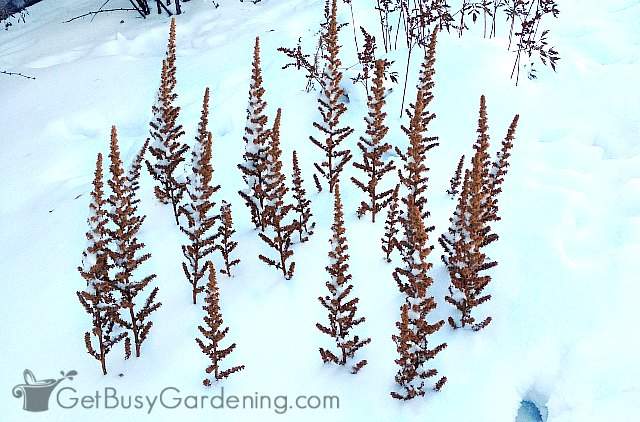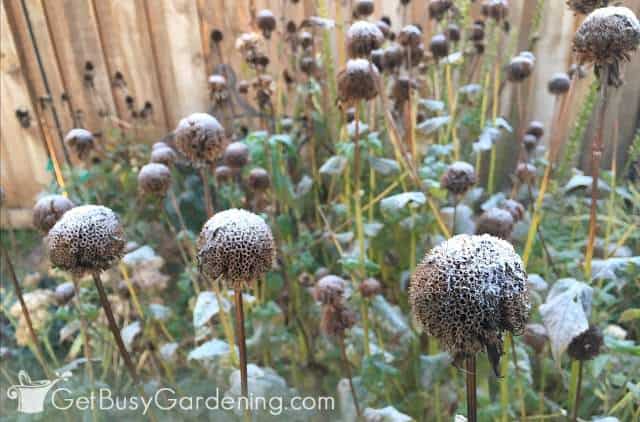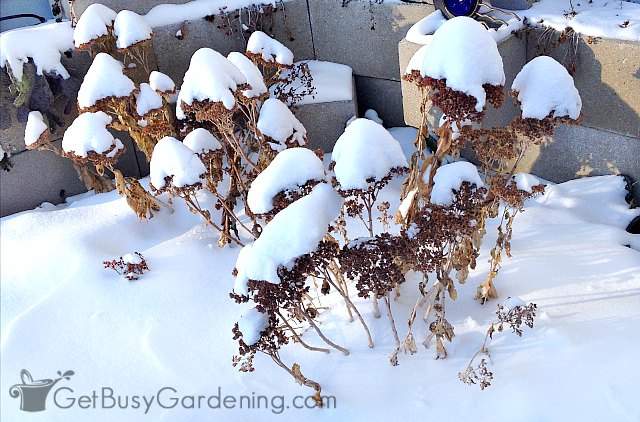Winter interest plants are a wonderful addition to any garden. Not only do they add beauty to the otherwise empty landscape, they also provide food and shelter for wildlife, and allow you to enjoy your gardens all year round.
In this post, I’ll explain what it’s all about, tell you the benefits, and share a list of my favorite plants that add interest to the winter landscape.
I’ve been thinking a lot about winter interest in the garden lately. It’s probably because old man winter has not been kind to us so far this year, giving us lots of cold and snow.
On these frigid days where nobody wants to be outside, I appreciate the frosty plants that stand tall above the snow more than ever.
I used to be the kind of person that had to completely clean out my gardens every fall. I would spend hours removing every last piece of plant material. As a result, after a few inches of snow, you could look out into my backyard and you’d never know there were gardens out there. It made me so sad.
Not anymore! Now I leave many different plants that add excitement and color to the otherwise-barren landscape. They remind me of my flowers, so I know that there really is still life under the frozen snow and ice – it’s just hibernating.
What Is Winter Interest?
Creating winter interest in the garden simply means that you leave plants in your yard that will stick out above the snow so that you can see them all season long.
It’s a great way to continue to enjoy your gardens year-round, especially when the landscape would otherwise be desolate.
Many people leave plants through the winter because they like to split their cleanup between the fall and spring. Another good reason is so that animals and birds have a source of food, and beneficial insects have shelter to hibernate.
The Benefits of Winter Interest Plants
One of the main benefits of winter interest plants is to design and create perennial gardens that you can enjoy all year round. Here are a few other advantages:
- Alleviates cabin fever – I love seeing the bloom spikes capped with frost or dusted by snow, it’s so beautiful. Plus watching the acrobatic squirrels dangling from flower heads, and the birds feasting on seeds is so much fun. It definitely helps to ease the ache of spring fever.
- Adds excitement – These days, my winter gardens are full of life. My favorite birds are constantly visiting, as well as furry creatures like squirrels and rabbits. It’s fun to look out there and see all of the movement and activity that’s going on, even on the coldest of days.
- Gets you outside – Maybe this is just me, but I find that winter interest plants make great subjects for photography. I see something cool out there almost every day, which gives me a good reason to grab my camera and get outside.
- Benefits wildlife – Leaving plants in the garden also benefits wildlife, providing shelter from the frigid temperatures and food sources that aren’t buried by snow. Lots of flowers will produce seeds that can feed them for months.
- Supports beneficial insects – Many types of beneficial bugs hibernate in dormant plant material or debris. So leaving plants through the winter will give the good bugs plenty of shelter so they can survive the long cold months.
Related Post: Salt Resistant Plants – Top 15 Perennials That Tolerate Salty Soil

17 Plants For Winter Interest In The Garden
To make it really easy for you to create a winter interest garden, I’ve put together a list of perennial plants and shrubs to get you started. They are all very common, and you might already have some of them:
Winter Interest Perennials
1. Liatris – Liatris is an excellent plant for winter interest because the thick flower spikes stand tall all season long. Plus they produce a plethora of seeds for your feathered and furry friends.
2. Astilbe – I love leaving astilbe in my garden through the winter because the flower spikes look like tiny trees sticking out of the snow. What could be more perfect than that? They’re so cute.

3. Tall grasses – Don’t forget to leave perennial grasses. Not only are they pretty to look at, they provide shelter for your favorite critters, and the seed heads are a great food source for them too.
4. Gaillardia – Another one of my favorite perennials with winter interest is gaillardia. The tall stems and flower heads look beautiful sticking up through the snow, and it’s also great for feeding the wildlife.
5. Coneflowers – This one is a must. Coneflowers look cute after snow has piled on top of their spent bloom heads, plus the seeds are another source of food for our feathered friends.

6. Clematis – Leaving clematis vines covering a trellis is an awesome addition to the winter garden. Snow will accumulate on the vines, and the seed pods can also be really cool looking.
7. Bee balm – Not only do bee balm plants add pops of color to our summer beds, they’re perfect for winter interest too. The flower spikes stand tall above the snow, and look fantastic when they’re covered by frost or snow.

8. Black-eyed Susan – With their tall stems and interesting flower heads, Black-eyed Susans are great to leave through the winter. Be careful with this one though, they tend to self-sow fairly aggressively.
9. Hardy yucca – Some types of yuccas are hardy perennial plants that stay green in winter. The spiky foliage looks really cool poking through the snow, and it adds a touch of color too.
10. Sedums – My favorite thing about leaving sedums in my winter garden is that, after it snows, they look like they’re wearing tiny white hats. It’s adorable, and they’re very photogenic.

Winter Interest Shrubs
11. Winterberry – This is one of the most well-known shrubs because of its bright red berries. The berries also make it one of the best bushes for creating year-round beauty, and wildlife enjoy feasting on them too.
12. Red twig dogwood – There are a few different types of dogwoods, so make sure to look for the ones with red, orange, or yellow stems so the bright colors pop against the white snow.
13. Arborvitae – These lovely evergreen shrubs are not only great plants for winter interest, they can also be an effective wind barrier from the frigid cold, and a shelter for wildlife.
14. Barberry bush – My barberry bushes are right next to the kitchen window, and not only do the red berries add color during the winter, it’s so much fun to watch the birds snacking on them.

15. Hydrangea – All types of hydrangeas make very pretty winter interest plants because their large flowers stay intact. Plus they are perfect for capturing the snow as it falls, which makes them look even more stunning.
16. Elderberry – Another one of the best shrubs for your winter garden, elderberry produces berries that are not only pretty, they’re another food source for wildlife.
17. Japanese maple – Even though Japanese maples lose their leaves in the fall, the interesting shape of their branches, along with the red stems against the stark white snow, can be stunning.
Your garden doesn’t have to be a boring, depressing, mass span of white all winter when you add some of these plants for interest. With a little planning (or maybe just a bit of laziness and procrastination), they can be gorgeous.
What winter interest plants would you add to this list? Share your top picks in the comments below.




Marieta says
I leave wild wine for the birds. They love them.
Despite my neighbour complaint of seeds on her side of the garden ;)))
Amy Andrychowicz says
Yes, plants that aggressively seed themselves aren’t the best to leave in the garden over the winter. But if the birds love them, then sometimes it’s worth it. 😉
Donna says
Amy I love this idea so much! I also leave up plants for the birds during the winter. They eat all the berries form my winterberry and viburnum even before it snows. Your list is much like mine and those are mostly natives that you have on your list. I also plant helianthus for winter interest and seed for birds.
Amy Andrychowicz says
I’m so glad you enjoyed the post! I usually grow sunflowers too, and the birds love them (oh, and the squirrels do too!!). These are usually the ones they eat before winter, haha! But there are always plenty of other plants out there all winter, and most of them stand high above the snow, so they still find plenty of food.
Beth says
I’ve traveled a similar journey on this issue of leaving plants in the garden over winter that have seeds to feed to birds. Except that I often just didn’t get around to cutting down the seed heads in the past. I tend to have tons more energy in the springtime for gardening chores. Now it’s a combo of laziness and intentional planning. In any case, it’s true–the dried perennials do provide winter interest, and we definitely need that here in the north country!
Amy Andrychowicz says
I hear you, I’m usually more motivated and energetic in the spring too. But thinking about this sure makes it easier in the fall to plan what to leave for the birds, and not feel guilty about it. I definitely enjoy the winter interest too, it reminds me that my gardens still exist somewhere under all that snow.
Sue says
I agree completely about keeping plants in the garden for winter for the wildlife, Amy. I had a coyote in my back garden this past winter, which was so fun to watch!
Amy Andrychowicz says
Oh wow!! That must have been really cool (though a bit scary!) to see! I don’t think that coyote was after your plants though, probably the rabbits or squirrels that were feeding on the plants in your winter garden. It’s good pest control! 🙂
El Caucho says
I don’t have anything specifically for winter interest, but do some of the same things you do, leave sedums and other flowers stalks instead of cutting them down. There are some Karl Forester grasses that look great in the snow right now. We also leave the various garden decorations outside throughout the winter, and I definitely consider “How would this look with snow on it” before I repurpose something into a trellis or arbor.
Amy Andrychowicz says
That’s awesome! It’s fun to see how everything in the garden looks when it’s covered by snow. It gives me more ideas for next year!